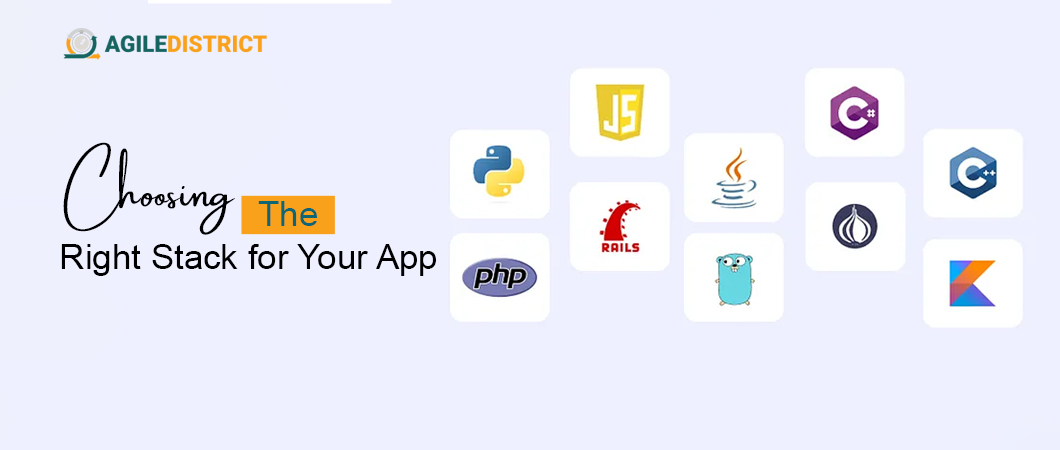Why Choosing the Right Backend Stack in 2025 Is More Important Than Ever
Choosing the correct backend technologies in 2025 is more critical than ever due to rapidly evolving market demands and tech innovation. Today’s users expect faster, more responsive apps that handle massive data volumes in real-time. The backend must be scalable, secure, and adaptable. With cloud-native technologies and microservices dominating the landscape, your choice can affect everything from cost to maintenance. At Agile District, our backend development company experts evaluate client needs holistically to select optimal stacks. Poor decisions now can lead to performance bottlenecks later. Future-proofing your app means investing in the right technology foundation today.
Top 2025 Backend Technologies Powering Enterprise-Grade Applications
As we move through 2025, several backend technologies are leading the charge in enterprise development. Node.js remains a favorite for its speed and vast ecosystem, while Python excels in AI-driven applications. Go is emerging for high-concurrency systems, Rust for performance-critical tasks, and Kotlin is gaining traction beyond Android development. Agile District, a seasoned backend development company, leverages these technologies to tailor backend stacks to business objectives. These tools offer a combination of performance, scalability, and developer friendliness that meet modern enterprise demands. Choosing the right one ensures your app delivers speed, efficiency, and security at scale.
How Agile District Selects the Ideal Backend Stack for Each Client
At Agile District, our backend development process begins with understanding your business goals. We assess project scope, scalability needs, and security requirements before choosing the most suitable backend technologies. From real-time chat apps to data-heavy platforms, our team maps out tech stacks that ensure agility and performance. We leverage Node.js, Python, and Go for startups needing fast time-to-market, and Rust or Java for enterprise-level solutions. As a full-service backend development company, we guide you from technology selection to deployment. Our goal is to empower your business with a backend stack that performs and evolves with you.
Comparing Performance, Scalability, and Security of Leading Backend Technologies
When choosing backend technologies in 2025, it’s essential to evaluate them on performance, scalability, and security. Node.js offers excellent real-time processing but may lack in CPU-bound tasks. Python is versatile and AI-friendly, though slower than compiled languages. Go shines in concurrency, making it great for cloud apps, while Rust brings memory safety and speed. Kotlin balances modern syntax with enterprise reliability. Agile District, as your trusted backend development company, compares these aspects for each project to deliver efficient, secure applications. Matching the tech stack to your business logic is key to creating a resilient, future-ready backend infrastructure.
The Rise of Serverless Architecture and Its Impact on Backend Development
Serverless architecture is revolutionizing how we think about backend development. In 2025, businesses increasingly adopt serverless to cut costs, reduce infrastructure complexity, and improve scalability. Technologies like AWS Lambda, Google Cloud Functions, and Azure Functions allow backend processes to run on demand, enhancing efficiency. This paradigm shift enables faster deployments and simplified maintenance. At Agile District, we help companies integrate serverless into their backend architecture to drive innovation without the overhead. As a forward-thinking backend development company, we believe serverless complements traditional stacks, offering flexibility and performance for dynamic applications with unpredictable workloads.
Microservices vs. Monolithic: What’s Best for Your 2025 App?
Choosing between microservices and monolithic architectures is a crucial decision in backend technologies. Microservices offer modularity and scalability, perfect for large, evolving apps. They let teams develop, test, and deploy features independently. Monolithic structures, while simpler to deploy initially, can become unwieldy as projects grow. In 2025, microservices dominate complex enterprise systems, but monoliths still work for MVPs and smaller apps. Agile District evaluates each client’s requirements to decide the best architecture. As a seasoned backend development company, we implement architecture that balances performance with maintainability, ensuring your app adapts to user needs and business growth.
How a Backend Development Company Like Agile District Ensures Future-Ready Solutions
Agile District stands out as a leading backend development company by providing tailor-made solutions built on cutting-edge backend technologies. Our team continuously monitors trends and evaluates emerging stacks to stay ahead. We offer clients a tech roadmap, robust CI/CD pipelines, and API-first design strategies. Our agile workflows and transparent communication ensure that every backend we develop supports scalability, performance, and security. Whether you’re launching a startup or scaling a global platform, we provide backend infrastructure built for longevity. Our client-first approach ensures that technology serves your business goals, not the other way around.
Cost, Talent Availability, and Ecosystem: Evaluating Your Stack Beyond the Code
While performance is vital, business leaders must also weigh cost, talent availability, and community support when selecting backend technologies. Some stacks have larger talent pools and lower learning curves, reducing hiring and training costs. Others may have extensive libraries and community support that speed up development. Agile District helps clients balance these factors alongside technical merit. As an experienced backend development company, we assess long-term project sustainability. Whether it’s choosing Python for its versatility or Go for its cloud-native appeal, we ensure your backend stack aligns with both current and future resource capabilities.
Future Forecast: What the Next Decade Looks Like for Backend Technologies
Looking beyond 2025, backend technologies will continue to evolve toward more intelligent, decentralized, and autonomous systems. AI will increasingly be integrated into backend logic, and blockchain could redefine data integrity and trust. Languages like Rust and Kotlin will become mainstream, while low-code backend platforms will grow in popularity. Agile District is preparing clients today for tomorrow’s demands. As your innovative backend development company, we explore and adopt trends that enhance backend performance and reduce technical debt. Staying adaptable is the key, and with the right tech partner, your backend will be ready for whatever the future holds.
